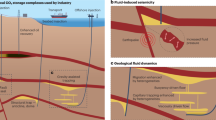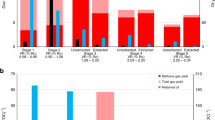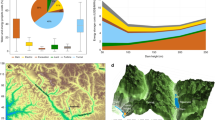Abstract
Meeting inter-seasonal fluctuations in electricity production or demand in a system dominated by renewable energy requires the cheap, reliable and accessible storage of energy on a scale that is currently challenging to achieve. Commercially mature compressed-air energy storage could be applied to porous rocks in sedimentary basins worldwide, where legacy data from hydrocarbon exploration are available, and if geographically close to renewable energy sources. Here we present a modelling approach to predict the potential for compressed-air energy storage in porous rocks. By combining this with an extensive geological database, we provide a regional assessment of this potential for the United Kingdom. We find the potential storage capacity is equivalent to approximately 160% of the United Kingdom’s electricity consumption for January and February 2017 (77–96 TWh), with a roundtrip energy efficiency of 54–59%. This UK storage potential is achievable at costs in the range US$0.42–4.71 kWh−1.
This is a preview of subscription content, access via your institution
Access options
Access Nature and 54 other Nature Portfolio journals
Get Nature+, our best-value online-access subscription
$29.99 / 30 days
cancel any time
Subscribe to this journal
Receive 12 digital issues and online access to articles
$119.00 per year
only $9.92 per issue
Buy this article
- Purchase on Springer Link
- Instant access to full article PDF
Prices may be subject to local taxes which are calculated during checkout





Similar content being viewed by others
Data availability
The data used to determine the predictive models are provided in the ‘TrainSet’ and ‘TestSet’ sheets of Supplementary Data 1. The conversion rates used for the costings are provided in the ‘Conversions’ sheet of Supplementary Data 1. The hydrocarbon volumes data are provided in Supplementary Table 4. The CO2 Stored data that support the findings of this study are available from the British Geological Survey and The Crown Estate, but restrictions apply to the availability of the data, which were used under licence for the current study, and so are not publicly available. Data are, however, available from http://www.co2stored.co.uk/ after registration, which grants free access. Full data download is considered on a case by case basis by the British Geological Survey and The Crown Estate. Other data and materials, not specified above, are available from the authors upon reasonable request.
References
Lott, M. C. & Kim, S.-I. Technology Roadmap Energy Storage (International Energy Agency, 2014); https://www.iea.org/publications/freepublications/publication/TechnologyRoadmapEnergystorage.pdf
Elliott, D. A balancing act for renewables. Nat. Energy 1, 15003 (2016).
G.B. National Grid Status (GridWatchUK, accessed 22 November 2018); http://www.gridwatch.templar.co.uk/index.php
Global Energy Storage Database (US Department of Energy, accessed 22 November 2018); http://www.energystorageexchange.org/
Rosenberg, D. M., Bodaly, R. A. & Usher, P. J. Environmental and social impacts of large scale hydro-electric development: who is listening?. Glob. Environ. Change 5, 127–148 (1995).
Succar, S. & Williams, R. Compressed Air Energy Storage : Theory, Resources, and Applications for Wind Power (Princeton Environmental Institute, 2008); https://acee.princeton.edu/wp-content/uploads/2016/10/SuccarWilliams_PEI_CAES_2008April8.pdf
Chen, H. et al. Progress in electrical energy storage system: a critical review. Prog. Nat. Sci. 19, 291–312 (2009).
Amid, A., Mignard, D. & Wilkinson, M. Seasonal storage of hydrogen in a depleted natural gas reservoir. Int. J. Hydrogen Energy 41, 5549–5558 (2016).
Zakeri, B. & Syri, S. Electrical energy storage systems: a comparative life cycle cost analysis. Renew. Sustain. Energy Rev. 42, 569–596 (2015).
Crotogino, F., Mohmeyer, K.-U. & Scharf, R. Huntorf CAES: more than 20 years of successful operation. In Solution Mining Research Institute (SMRI) Spring Meeting 351–357 (2001); http://www.fze.uni-saarland.de/AKE_Archiv/AKE2003H/AKE2003H_Vortraege/AKE2003H03c_Crotogino_ea_HuntorfCAES_CompressedAirEnergyStorage.pdf
Kaiser, F. Steady state analyses of existing compressed air energy storage plants thermodynamic cycle modeled with engineering equation solver. In Power and Energy Student Summit (PESS) (Energie-Forschungszentrum Niedersachsen, 2015); https://eldorado.tu-dortmund.de/bitstream/2003/33983/1/S02.2.pdf
Mason, J. E. & Archer, C. L. Baseload electricity from wind via compressed air energy storage (CAES). Renew. Sustain. Energy Rev. 16, 1099–1109 (2012).
Helsingen, E. M. Adiabatic Compressed Air Energy Storage (Norwegian University of Science and Technology, 2015); https://brage.bibsys.no/xmlui/handle/11250/2350057
Kim, Y. M., Lee, J. H., Kim, S. J. & Favrat, D. Potential and evolution of compressed air energy storage: energy and exergy analyses. Entropy 14, 1501–1521 (2012).
Oldenburg, C. M. & Pan, L. Utilization of CO2 as cushion gas for porous media compressed air energy storage. Greenhouse Gases Sci. Technol. 3, 124–135 (2013).
Buscheck, T. A. et al. Multifluid geo-energy systems: using geologic CO2 storage for geothermal energy production and grid-scale energy storage in sedimentary basins. Geosphere 12, 678–696 (2016).
Bentham, M., Mallows, T., Lowndes, J. & Green, A. CO2 STORage Evaluation Database (CO2 Stored). The UK’s online storage atlas. Energy Procedia 63, 5103–5113 (2014).
Kolditz, O. et al. OpenGeoSys: an open-source initiative for numerical simulation of thermo-hydro-mechanical/chemical (THM/C) processes in porous media. Environ. Earth Sci. 67, 589–599 (2012).
Smith, R. V. Determining friction factors for measuring productivity of gas wells. Petrol. Trans. 189, 73–82 (1950).
Barbour, E., Mignard, D., Ding, Y. & Li, Y. Adiabatic compressed air energy storage with packed bed thermal energy storage. Appl. Energy 155, 804–815 (2015).
Flanigan, O. in Underground Gas Storage Facilities: Design and Implementation Ch. 6, 54–67 (Gulf Publishing Company, Houston, 1995).
Mouli-Castillo, J. Assessing the Potential for Compressed Air Energy Storage Using the Offshore UK Saline Aquifer Resource. PhD thesis, Univ. Edinburgh (2018).
Allen, R. D., Doherty, T. J., Erikson, R. L. & Wiles, L. E. Factors Affecting Storage of Compressed Air in Porous-Rock Reservoirs (Pacific Northwest Laboratory, 1983).
Castelletto, N. et al. 3D geomechanics in UGS projects: a comprehensive study in northern Italy. In 44th American Rock Mechanics Association Symposium 2010, ARMA-10-185 (UGS, 2010); https://site.tre-altamira.com/wp-content/uploads/2010_3D_geomechanics_in_UGS_projects_comprehensive_study_in_northern_Italy.pdf
Watson, K. & Jones, C. Cyclic loading of a rock mass for underground gas storage applications. In SIMULIA Customer Conference 1–9 (Dassault Systèmes, 2010); http://www.simulia.com/download/scc-papers/Energy/cyclic-loading-rock-mass-underground-gas-storage-2010-F.pdf
Aadnoy, B. S. & Kaarstad, E. History model for sand production during depletion. In SPE EUROPEC/EAGE Annual Conference and Exhibition 14–17 (Society of Petroleum Engineers, 2010); https://doi.org/10.2118/131256-MS
Oldenburg, C. M. & Pan, L. Porous media compressed-air energy storage (PM-CAES): theory and simulation of the coupled wellbore–reservoir system. Transp. Porous Media 97, 201–221 (2013).
Allen, R. D. & Gutknecht, P. J. Porous Media Experience Applicable to Field Evaluation for Compressed Air Energy Storage (Pacific Northwest Laboratory, 1980); https://www.osti.gov/servlets/purl/5319221
Maton, J.-P., Zhao, L. & Brouwer, J. Dynamic modeling of compressed gas energy storage to complement renewable wind power intermittency. Int. J. Hydrogen Energy 38, 7867–7880 (2013).
Pan, L. & Oldenburg, C. M. in Computational Models for CO 2 Geo-sequestration and Compressed Air Energy Storage (eds Al-Khoury, R. & Bundschuh, J.) 479–498 (CRC Press, London, 2014).
SMARTCAES (Dresser-Rand, accessed 22 November 2018); http://www.dresser-rand.co.uk/products-solutions/systems-solutions/compressed-air-energy-storage-solutions/
Grazzini, G. & Milazzo, A. A thermodynamic analysis of multistage adiabatic CAES. Proc. IEEE 100, 461–472 (2012).
Xing, L. & Jihong, W. Overview of Current Development on Compressed Air Energy Storage, Technical Report (EERA, 2013); https://www.eera-set.eu/wp-content/uploads/Overview-of-Current-Development-on-Compressed-Air-Energy-Storage_EERA-report-2013.pdf
Liu, W. et al. Analysis and optimization of a compressed air energy storage—combined cycle system. Entropy 16, 3103–3120 (2014).
Wilkinson, M. et al. Defining simple and comprehensive assessment units for CO2 storage in saline formations beneath the UK North Sea and continental shelf. Energy Procedia 4, 4865–4872 (2011).
Evans, D. et al. Initial Studies to Derive Estimates of Potential UK Salt Cavern Volumes and Exergy Storage (CAES) (2016); http://energysuperstore.org/esrn/wp-content/uploads/2017/01/UKES2016_David-Evans-Initial-Studies-to-Derive-Estimates-of-Potential-UK-Salt-Cavern-Volumes-and-Exergy-Storage.pdf
Well Data (Oil and Gas Authority, accessed 9 October 2017); https://www.ogauthority.co.uk/data-centre/data-downloads-and-publications/well-data/
Kittner, N., Lill, F. & Kammen, D. M. Energy storage deployment and innovation for the clean energy transition. Nat. Energy 2, 17125 (2017).
Kushnir, R., Ullmann, A. & Dayan, A. Thermodynamic and hydrodynamic response of compressed air energy storage reservoirs: a review. Rev. Chem. Eng. 28, 123–148 (2012).
Wang, B. & Bauer, S. Pressure response of large-scale compressed air energy storage in porous formations. Energy Procedia 125, 588–595 (2017).
Niemela, S. I., Sivela, C., Luoma, T. & Tuovinen, O. H. Maximum temperature limits for acidophilic, mesophilic bacteria in biological leaching systems. Appl. Environ. Microbiol. 60, 3444–3446 (1994).
Madigan, M. T., Martinko, J. M., Dunlap, P. V. & Clark, D. P. Brock biology of microorganisms. Int. Microbiol. 11, 65–73 (2008).
Kalantarian, A., David, R., Chen, J. & Neumann, A. W. Simultaneous measurement of contact angle and surface tension using axisymmetric drop-shape analysis–no apex (ADSA-NA). Langmuir 27, 3485–3495 (2011).
BERR Well Production (BERR, 2007); https://itportal.decc.gov.uk/information/wells/pprs/Well_production_offshore_gas_fields/offshore_gas_fields_by_well/offshore_gas_fields_by_well.htm
Al-ajmi, A. M. & Zimmerman, R. W. Stability analysis of vertical boreholes using the Mogi–Coulomb failure criterion. Int. J. Rock Mech. Min. Sci. 43, 1200–1211 (2006).
Wall, M., Lee, R. & Frost, S. Offshore Gas Turbines (and Major Driven Equipment) Integrity and Inspection Guidance Notes (ESR Technology Ltd for the Health and Safety Executive, 2006); http://www.hse.gov.uk/research/rrpdf/rr430.pdf
Kutun, K., Tureyen, O. & Satman, A. Analysis of wellhead production temperature derivatives. In Proc. 40th Workshop on Geothermal Reservoir Engineering, Stanford University 26–28 (Stanford Geothermal Program SGP-TR-204, 2015); http://docplayer.net/49385718-Analysis-of-wellhead-production-temperature-derivatives.html
Mudge, D. C. & Bujak, J. P. An integrated stratigraphy for the Paleocene and Eocene of the North Sea. Geol. Soc. London Spec. Publ. 101, 91–113 (1996).
Liu, W. et al. Performance analysis of a coal-fired external combustion compressed air energy storage system. Entropy 16, 5935–5953 (2014).
Ahmadi, Z. et al. in The Millennium Atlas: Petroleum Geology of the Central and Northern North Sea (eds Evans, D., Graham, C., Armour, A. & Bathurst, P.) 253–259 (Geological Society, London, 2003).
Knox, R. W. & Holloway, S. in Lithostratigraphic Nomenclature of the UK North Sea (eds Knox, R. W. & Cordey, W. G.) Ch. 1 (British Geological Survey, Nottingham, 1992).
Kilhams, B. A. An Integrated Characterisation of the Paleocene Submarine Fan Systems (Lista and Maureen Formations) in the Central Graben of the North Sea. PhD thesis, Univ. Aberdeen (2011).
Kilhams, B., Hartley, A., Huuse, M. & Davis, C. Characterizing the Paleocene turbidites of the North Sea: the Mey Sandstone Member, Lista Formation, UK Central Graben. Petrol. Geosci. 18, 337–354 (2012).
Munns, J. W., Gray, J. C., Stoker, S. J., Andrews, I. J. & Cameron, T. D. J. The remaining hydrocarbon potential of the UK Continental Shelf. In Petroleum Geology: North-West Europe and Global Perspectives—Proc. 6th Petroleum Geology Conference (eds Doré, A. G. & Vining, B. A.) 41–54 (Geological Society, London, 2005).
Xia, C. & Wilkinson, M. Quantifying the geological risk of drilling a borehole for CO2 storage. Int. J. Greenhouse Gas Control 63, 272–280 (2017).
Progressing Development of the UK’s Strategic Carbon Dioxide Storage Resource: A Summary of Results from the Strategic UK CO 2 Storage Appraisal Project (Pale Blue Dot Energy, 2016); https://onedrive.live.com/view.aspx?cid=56FC709A2072366C&authKey=%21ANk4zmABaDBBtjA&resid=56FC709A2072366C%211573&ithint=%2Epdf&open=true&app=WordPdf
Transmission Costs for Offshore Wind. Final Report April 2016 (Offsore Wind Programme Board, 2016); https://ore.catapult.org.uk/app/uploads/2018/02/Transmission-Costs-for-Offshore-Wind.pdf
Mignard, D. Estimating the capital costs of energy storage technologies for levelling the output of renewable energy sources. Int. J. Environ. Stud. 71, 796–803 (2014).
Steward, D., Saur, G., Penev, M. & Ramsden, T. Lifecycle Cost Analysis of Hydrogen Versus Other Technologies for Electrical Energy Storage (NREL, 2009); https://www.nrel.gov/docs/fy10osti/46719.pdf
Exchange Rate Archives by Month: Data and Statistics (IMF, accessed 10 October 2018); https://www.imf.org/external/np/fin/data/param_rms_mth.aspx
US Department of Labor Databases, Tables and Calculators by Subject: CPI Inflation Calculator (Bureau of Labor Statistics, accessed 15 October 2018); https://www.bls.gov/data/inflation_calculator.htm
Obi, M., Jensen, S. M., Ferris, J. B. & Bass, R. B. Calculation of levelized costs of electricity for various electrical energy storage systems. Renew. Sustain. Energy Rev. 67, 908–920 (2017).
McGrail, B. P. et al. Techno-economic Performance Evaluation of Compressed Air Energy Storage in the Pacific Northwest, PNNL-22235 (US Department of Energy, 2013); https://caes.pnnl.gov/pdf/PNNL-22235.pdf
Eckroad, S. & Gyuk, I. EPRI-DOE Handbook of Energy Storage for Transmission and Distribution Applications, report no. 1001834 (US Department of Energy, 2003); www.sandia.gov/ess/publications/ESHB%201001834%20reduced%20size.pdf
Acknowledgements
This work has been funded by the Engineering and Physical Science Research Council (EPSRC) of the United Kingdom and by the Energy Technology Partnership. The authors thank E.V. Hipkins for her proof reading of the draft, as well as the Geofluids research group from the University of Edinburgh for their suggestions.
Author information
Authors and Affiliations
Contributions
J.M.-C. co-developed the methodological approach and the models and performed the sensitivity analysis, data set screening and Monte Carlo simulation. M.W. conceptualized the study, co-developed the methodology for the screening of the UK data set, proposed the conceptual design of the idealized store model and provided significant input into the research coordination. D.M. co-developed the combustor model and verified the compressor and turbine models, provided the costings of the turbine and compressors, and contributed to the development of the predictive models. C.M. co-developed the numerical store models in OpenGeoSys. R.S.H. contributed to the costing methodology and conceptualized the study. Z.K.S. contributed to the conceptual store model development, in particular the geomechanical limitations of it. All authors made significant contributions and revisions to the manuscript itself.
Corresponding author
Ethics declarations
Competing interests
The authors declare no competing interests.
Additional information
Publisher’s note: Springer Nature remains neutral with regard to jurisdictional claims in published maps and institutional affiliations.
Supplementary information
Supplementary Information
Supplementary Figures 1–4, Supplementary Tables 1–8, Supplementary References
Supplementary Data 1
The “Costings” sheet contains the costings established using carbon capture and storage site costings as analogues, as well as hypothetical sites using areas highlighted by this research. The “Conversions” sheet presents the cost conversion from the original values reported in the literature to 2018 US dollars. The “TrainSet” sheet contains the results from the store, well and plant models used to determine the predictive models, along with the associated statistical summaries. The “TestSet” sheet contains the results from the store, well and plant models used to test the predictive accuracy of the predictive models, along with the reported Pearson coefficient between the modeled and predicted values
Rights and permissions
About this article
Cite this article
Mouli-Castillo, J., Wilkinson, M., Mignard, D. et al. Inter-seasonal compressed-air energy storage using saline aquifers. Nat Energy 4, 131–139 (2019). https://doi.org/10.1038/s41560-018-0311-0
Received:
Accepted:
Published:
Issue Date:
DOI: https://doi.org/10.1038/s41560-018-0311-0
This article is cited by
-
Development and technology status of energy storage in depleted gas reservoirs
International Journal of Coal Science & Technology (2024)
-
Quantifying microstructures of earth materials using higher-order spatial correlations and deep generative adversarial networks
Scientific Reports (2023)
-
An environmental information system for the exploration of energy systems
Geothermal Energy (2022)
-
The design space for long-duration energy storage in decarbonized power systems
Nature Energy (2021)
-
BMC Energy: a home for all energy and fuels research
BMC Energy (2019)



